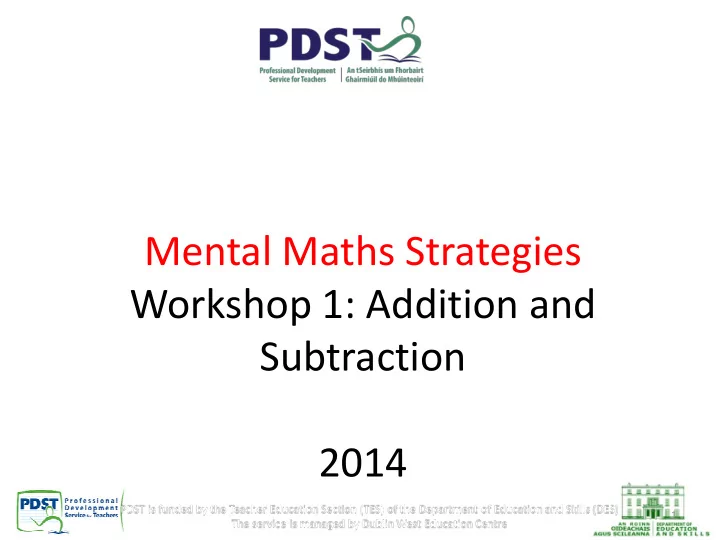

Mental Maths Strategies Workshop 1: Addition and Subtraction 2014 1
Overview Workshop 1 Workshop 2 • May 2014 • School year 2014/2015 • Addition and • Multiplication and subtraction division strategies strategies 2
Support Materials PDST Workshop Booklet PDST Mental Maths Handbook 3
What is Mental Maths? • Sorting activity • Teacher Reflection 4
Key Messages 1. Concrete and pictorial exploration of number is the foundation of mental maths strategy development 2. Pupils should devise, communicate and reflect on various mental maths strategies 3. The teacher’s role is to facilitate mathematical thinking 5
Objectives • To broaden participants perception of mental maths • To reflect on how pupils are encouraged to engage in mathematical thinking • To actively engage participants in identifying and naming mental maths strategies for addition and subtraction 6
8+8= 121+122= In your class, which do your pupils use most often? • rapid recall of known facts • application of known facts 7
Number Facts or Mental Maths “ Rapid recall of number facts is one aspect of mental calculation but there are others. This involves presenting children with calculations in which they have to work out the answer using known facts and not just recall it from a bank of number facts that are committed to memory.” (Crown, 2010, p.12) 8
Solid Foundations • Being able to confidently add and subtract any pair of two-digit numbers mentally is an important starting point for mental maths. 9
6 aspects of maths that involve mental calculation Hypothesising Recalling Applying and Facts Facts Predicting Designing and Applying Interpreting Comparing Reasoning Results Procedures Crown, 2010 10
Teacher as Facilitator • Starts by assessing the knowledge of the group • Information flows in many different directions • Facilitators elicit a variety of methods from pupils • Facilitators encourage pupils to critically evaluate solution methods 11
A Range of Methods… “To help children to learn and draw on a range of mental methods, you need to raise their awareness and understanding of the range of possible strategies, develop their confidence and fluency by practising using the strategies, and help them to choose from the range the most efficient method for a given calculation.” (Crown, 2010, p.15) 12
Stages of Progression • Counting Strategies – using object counting (for example blocks or fingers) or verbal counting to determine the answer. • Reasoning Strategies – using known information to logically determine an unknown combination. • Mastery – efficient (fast and accurate) I just know it production of answers. Arthur Baroody (2006) 13
Mental Strategies for + and - COUNTING 14
Name the strategy… • 160 + 170 • 404 – 200 Handbook p.19, 20 15
Name the strategy… • 164 + 206 • 150 - 28 Handbook p. 21 16
Name the strategy… • 65 + 7 • 1.4 + 1.7 Handbook p.21, 22 17
Name the strategy… • 58 + 47 – 38 • 4.7 + 5.6 – 0.7 Handbook p. 22 18
Name the strategy… • 109 + 256 • 96 - 55 Handbook p.23, 24 19
Name the strategy… • 6.8 - 4.9 • 5.7 + 3.9 Handbook p. 24, 25 20
Name the strategy… • 15.20pm – 3h 40 • 6.30am + 40 minutes minutes Handbook p.26 - 27 21
Name the strategy… • 1088 – 975 • 124 – 97 Handbook p.28-29 22
Name the strategy… • 51 – 26 • 2448 – 298 • 209 – 151 Handbook p.29 - 31 23
Addition and Subtraction Strategies Counting forwards Doubles/near Facts of 10 and backwards doubles Bridging through Partitioning by Reordering ten(s) place value Subtraction Bridging through • Think addition Compensating 60 (time) • Keeping a constant difference 24
The Test ! No pressure You can work with a partner to figure them out 25
Mastering the Basic Facts Do: Avoid: 1. Ask students to self- 1. Using lengthy timed tests monitor 2. Using public comparisons of 2. Focus on self improvement mastery 3. Drill in short time segments 3. Proceeding through facts in order from 0 to 9 4. Work on facts over time 4. Moving to memorisation 5. Involve families too soon 6. Make drill enjoyable 5. Using facts as a barrier to 7. Use technology good mathematics 8. Emphasise the importance of quick recall of facts Van de Walle, p. 188 26
Steps to Success for Pupils with SEN… 1. Recognise that more drill will not work 2. Provide hope 3. Inventory – the known and unknown facts for each student in need 4. Diagnose strengths and weaknesses 5. Focus on reasoning strategies 6. Build in success 7. Provide engaging activities for drill Van de Walle (p.186/187) 27
Reflect again Activity 1 : Re-sort statements Activity 2: Reflection booklet pg 5 28
PDST Supports • Session 2 Term 1 2014 • www.pdst.ie
Recommend
More recommend